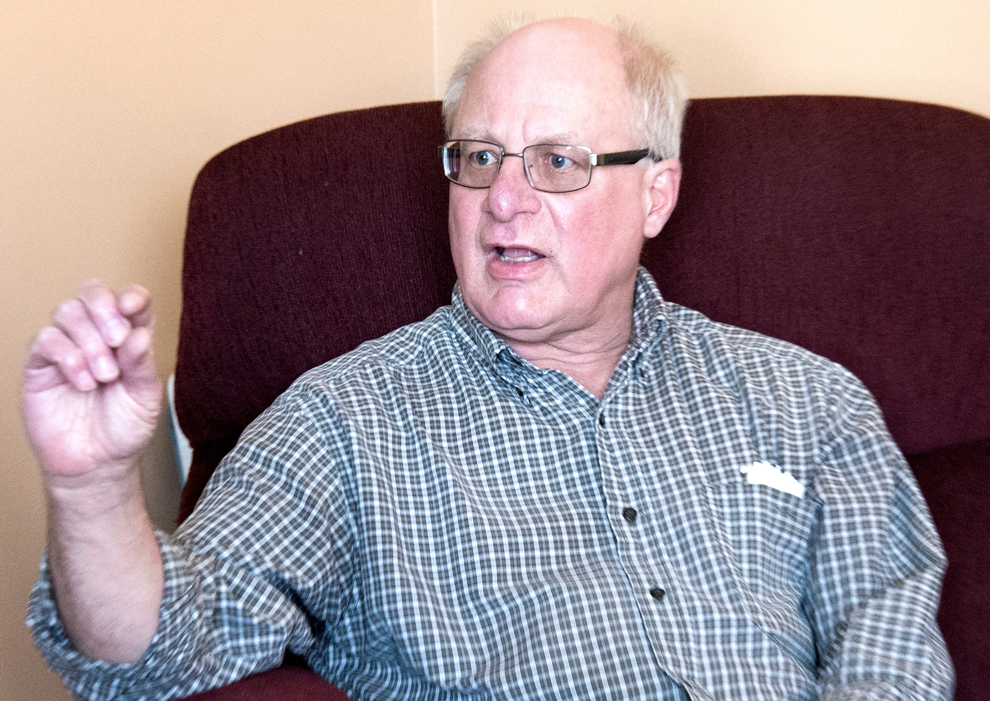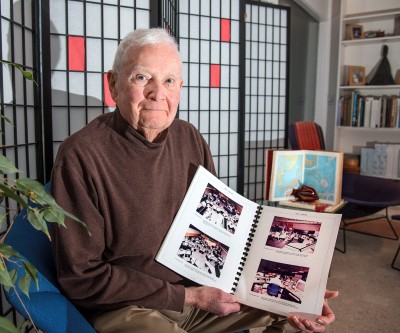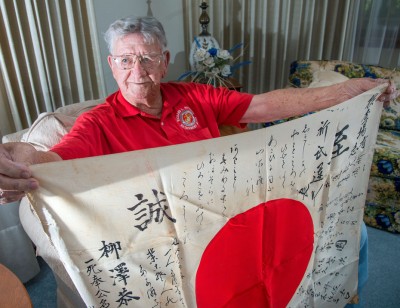Steve Douglas
By Paul Wood

Photo By Robin Scholz/The News-Gazette
RANTOUL — You know you’re in a typhoon when you have to jam your knees into the sand just to stay upright.
That’s what Vietnam veteran Spec. 4 Steve Douglas remembers about being stationed at logistics base “Wunder Beach” — nicknamed for Col. Charles Sunder, whose men took the beach in 1968.
During Typhoon Bess, the Wunder was going under.
Winds ripped through Army tents and shanties at 85 miles an hour in September 1968, Douglas recalls.
Soldiers heated barely edible ham and lima beans on engine exhaust manifolds while hunkering down.
“For three days, the weather got worse day by day,” he recalls.
At other times in the war, he delivered “everything from napalm to baby food” to troops just south of the North Vietnam border.
His “Vietnam 365 and a wake-up,” to leave, ended with a transfer to military police, then a return to civilian life in a native land where the war had become increasingly unpopular.
The Rantoul native enlisted in December 1967 at 18, after first trying to get into the Coast Guard.
“My eyes failed me,” he says.
“They asked me, ‘if your glasses washed overboard, you wouldn’t be able to navigate, would you?’ I didn’t want to go into Marine Corps and become a Marine corpse.”
Douglas was interested in diesel engines, and an Army recruiter on South Neil Street in Champaign told him, “‘You know, the Army has a navy.’ It really piqued my interest.”
He said he was glad to join a transportation unit after going through amphibious engineering training in Virginia.
Once in Vietnam, Douglas manned a transport that was supposed to carry 60 tons per run.
“Like everything else the Army does, they overloaded it, carrying bombs and every kind of supplies,” he says.
What was supposed to be a four-man crew became a two-man crew.
The enemy was never far off.
“We were so young, we could have been nailed every time we went to the latrine,” he says. “You just stopped being scared. You had to.”
Douglas cites figures that in Vietnam, soldiers served in combat an average of 240 days. In World War II, soldiers saw an average of 40 days in combat.
At Wunder Beach, “everywhere we went there was concertina wire. You were on yellow alert, sometimes red alert,” he says.
“We never took incoming. We fired out a few times because we knew Charley was out there,” Douglas said.
During the South China Sea’s Typhoon Bess, tent poles swayed in the wind, and sand flew everywhere.
Waiting for rescue, they finally saw a speck on the horizon, growing slowly bigger.
It was the USS Cabildo, a Navy dock landing ship, and it picked up the stranded soldiers.
Though the ship was listing in the storm as much as 25 degrees, Douglas says, bilge pumps soon cleared the well decks for bringing in amphibious vehicles.
Suddenly, there were hot showers for the exhausted soldiers, air-conditioning in the 100-degree weather, toilets that flushed and food that didn’t come right out of a can.
“We watched a movie that first night,” he says.
At Vung Ro Bay, “we thought maybe we would take on provisions. No, this was our drop-off point.”
His company was attached to a stevedore unit, “very loosely,” he says.
“It was good duty, edible food there, too. I still remember ‘Cinderella Foods’ from Georgia,” he says.
But he still carries the P-38 can opener used for Spam, the meatish canned food, and fondly recalls rock-hard hardtack biscuits called “John Wayne cookies.”
Douglas says he was spit on at St. Louis on his return. The anti-war feeling died down, but there were never ticker-tape parades for Vietnam veterans.
“It’s been the eight or 10 last few years that we’ve had any recognition,” he says. “So many people said you got a raw deal. All we asked for was simple recognition.”
Once out of the service, he took classes at Parkland College, was an auto mechanic, then got another degree in business information systems at Parkland and worked in that field before retiring.
He is married to Linda, and they have one daughter.
Do you know a veteran who could share a story about military service? Contact staff writer Paul Wood at pwood@news-gazette.com.
Read more stories from local veterans:
 Robert Porter
CHAMPAIGN — Though his main service was in the Korean War, Robert Porter witnessed the aftermath of destruction on Nagas …
Robert Porter
CHAMPAIGN — Though his main service was in the Korean War, Robert Porter witnessed the aftermath of destruction on Nagas …
 Roger Thorson
CHAMPAIGN — Roger Thorson ran hot and cold in his military service. From 1980 to 2000, he was as close to the North Pole …
Roger Thorson
CHAMPAIGN — Roger Thorson ran hot and cold in his military service. From 1980 to 2000, he was as close to the North Pole …
 Jim Kelly
URBANA — When Jim Kelly was in the Marines, he met John Wayne in a bar. The film star bought him a drink in Laguna Beach …
Jim Kelly
URBANA — When Jim Kelly was in the Marines, he met John Wayne in a bar. The film star bought him a drink in Laguna Beach …